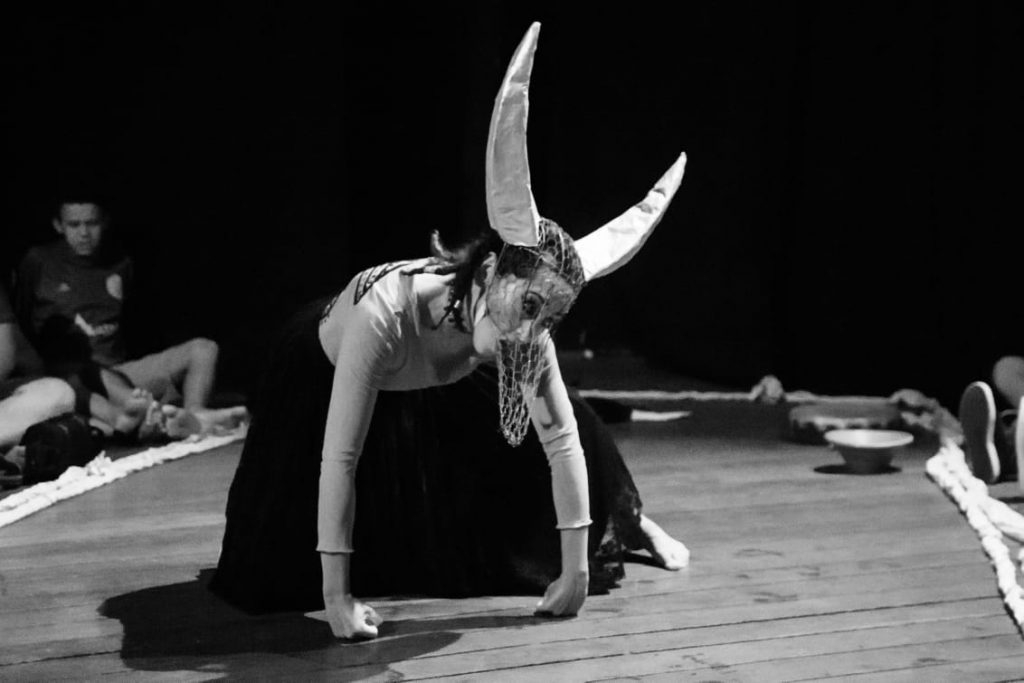São Paulo – The sacred bull Apis worshipped in Ancient Egypt was one of the references to create the performance Urrou by actress, dancer, and Brazilian popular culture researcher Mônica Alvarenga. The play is a solo by the artist directed by Ederson Cleiton and visits the bulls of the human history, from Apis to Bumba Meu Boy, a character in folklore festivals in Maranhão, Brazil.
The play was born from a research by the author and started being performed last year. It may be seen until the end of the month, May 24, at Sesc São José dos Campos, São Paulo, Brazil. “My performance is inspired by popular manifestations of the Bumba Meu Boi festival and bull worship rituals,” told Mônica in an interview to ANBA.
The author defines the play as poetic, ritualistic and political and says it is based on the birth, baptism, death and resurrection of Bumba Meu Boi, the same cycle of nature, with its seasons of Spring, Summer, Autumn and Winter, and Jesus Christ, she says. “Before Christianity, there was Mithraism, centered on the god Mithras, where they sacrificed a bull and drank its blood, and this was borrowed by Christians, who drink the blood of Christ, which is wine,” she says. The Apis bull, with its golden horns, is seen as the bull in its birth phase, while the last bull of humanity for the artist is Bumba Meu Boi, symbolizing death, with its red horn.
This story starts on the stage with the actress naked in a performance space defined by ropes with red knots, and surrounded by the audience, which participates in the play. The knots refer to the Apis bull, which has a knotted tongue, and the tongue of Bumba Meu Boi. Bumba Meu Boi festival is based on a legend of an ox that was killed and resurrected. The pregnant slave Catrina asked his husband an ox’s tongue to consume. After killing the animal, he found out the ox was the farm’s owner favorite and the animal was resurrected by the healers.
The artist starts naked so she can begin the play as herself, and then she gradually becomes a bull. “It is like the birth of the ox, the stitching in the ox leather,” she explains. The fact that a female artist plays a male ox lends a political tone of women’s empowerment to the play. The rope is laid diagonally on the stage referring to the Cretan Labyrinth, where king Minos locked the Minotaur, a a mythical creature portrayed in Greek mithology with the head of a bull and the body of a man.
The play has other elements such as shamanic drums – an instrument used in old rituals with music and dance – song from the African religion terecô, wine to distribute to the audience as at Bumba Meu Boi festival, bull heads made of wire, bowls to wash hands, and others. The body movement in the play is based on the body dance of Bumba Meu Boi connected with Laban, a dance technique where the movement create geometrical shapes. Research for the play started with this technique.
The play is a final project in the Laban and movement art course Mônica studied with theater director Denise Telles-Hofstra. The course happened in 2017 and ended in March 2018, resulting in the play. Those were three months of intense research, according to the author. “I had an idea to portray the relation between the mythological and totemic figure of the bull and the humanity in December 2017. In January 2018 I started the research to create the play,” she says.
During the research about the relation between humanity and the totemic figure of the bull, Mônica arrived at the Apis bull. “Considered the first mythological figure revered by humanity, where they worshipped, celebrated the bull,” she says. The author reminds that Africa and Brazil were together in Pangea, the supercontinent that existed in Earth until the Crustacean period. The play also refers to other bulls, such as those from bullfighting, medieval autos, the Taurus constellation, and the golden calf created by the Moses people.
In addition to the presentation at SESC São José dos Campos, Urrow will participate in some festivals until July, including Festival de Teatro Nacional de Bolso in Brasília, Festival Nepopó in São João Nepomuceno, and the Festival Internacional de Teatro Sapucaia in Santa Rita do Sapucaí. “Urrou” has already received several awards.
The play director, who is married to the artist, is also the scenographer, creator of the lighting projects, stunt guy, technician, and producer. Elisa Monteiro takes care of sound operation, production assistance, make-up, and photos. Conception and creation are all Mônica’s. She has worked with scenic arts for 23 years, with cultural research for 15 years, and has a dance studio, Ateliê Cênico de Dança in Pindamonhangaba, where she was born and lives.
Mônica studied Scenic Arts in Faculdade Santa Cecília (FASC) in Pindamonhangaba and specialized in dance and corporal science in FMU in São `Paulo. The artist also directs a professional dance company, Clã de Dança, and a popular theater company called Cia Núcleo Cênico, and has created the Brazilian popular culture study group for women Elekô Coletivo Cultural. She is the granddaughter of the writer and poet Maria José de Alvarenga.
Quick Facts:
Show Urrou
May 25, 2019 (Friday), at 9pm
SESC São José dos Campos
Av. Dr. Adhemar de Barros, 999 – Jardim Sao Dimas – São José dos Campos/SP, Brazil
Tickets BRL 5-17 (USD 1-4)
More information here
Translated by Guilherme Miranda




